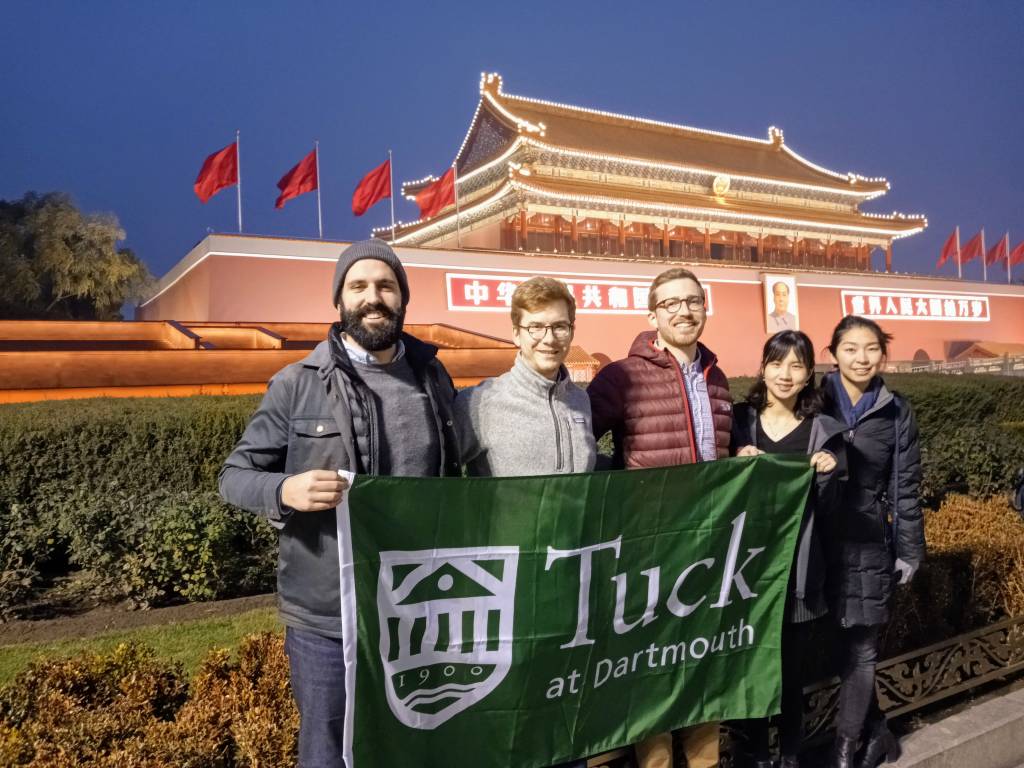On the Ground in China: Witnessing Digital Transformation at a Global Scale
January 9th, 2020Topics: AI & Machine Learning Big Data / Analytics Culture Customer Entrepreneurial Tech Global Infrastructure Manufacturing Marketing / Sales Privacy Robotics Value Chain

In the last decade, it has become increasingly clear that the Bay Area has new competition for tech dominance. We’re not talking about Seattle, New York, or Boston. We’re talking about the rise of China as a global tech superpower. Much like Google, Apple, Amazon, and Microsoft, Chinese tech firms have seen explosive growth over the last decade in particular. They are major players in ecommerce, infrastructure, hardware, cloud computing, and services. The rise of new players in China has been clear when you ask Tuck students to list the companies they watch as top innovators: Alibaba, Tencent, DiDi, Huawei, and JD frequently join major players in the United States. That’s why the Center for Digital Strategies created opportunities across the last two years for students to travel to China and learn more about the country’s tech ecosystem and culture.
What comes to mind when we ask you to name the largest or most relevant technology companies today? Odds are you named companies like Google, Amazon, Microsoft, or Apple. Or maybe you went the startup route, focusing on companies like Uber or Snapchat. The truth is, when we think about technology companies in the United States we traditionally focus on domestic companies, and for good reason. As Google, Amazon, Apple, and Microsoft all flirt with $1 trillion USD valuations, these companies are incredibly powerful and influential. However, the technology landscape today has a new crop of companies pushing the large US tech giants around the world. Alibaba, Tencent, JD.com, DiDi, TikTok, and others also shape technology around the world and need to be better understood by business leaders. In the center, we have taken notice of the rising importance of technology companies in China and set out to help Tuck students better understand the growth and influence of these Chinese technology firms and also the dynamics on the ground in China that fuel their rise as global technology players.
In line with Tuck’s mission of educating wise and decisive business leaders, the Center for Digital Strategies traveled to China with 5 second-year Tuck MBA students in November 2019 on our second annual learning deep dive to China. We believe deeply in the value of experiential learning and so focused on helping students immerse in Chinese culture, both ancient and modern, by directly engaging with executives at companies on the ground in Shanghai and Beijing.
Over the course of our trip, we visited nearly a dozen companies, sought out technology-fueled consumer experiences, and learned about the people and culture of two regions in China. Students returned home with diverse observations, impressions, and memories that will serve them well as they transition into leadership roles following completion of their MBA program at Tuck. Below is a compilation of their key takeaways from the trip.
-
China embraces mobile in ways not seen in the West
-
Scale is everything in China, and allows for rapid innovation
-
Understanding Chinese consumers is difficult, despite ubiquity of data
China Embraces Mobile in Ways Not Seen in the West
Mobile is not just another channel in China, it’s the only channel that matters. Chinese consumers have embraced mobile in ways which are much deeper than in the US and other western markets. The average Chinese consumer spends more than six hours a day on their mobile phones, compared to 3 in the US. And it’s not just the additional engagement that varies, it’s also how the Chinese app ecosystem works in China.
Whether we needed to order a car from Didi, pay for meals, or our near-collisions with people deeply immersed in a television show while they walked down the street, mobile phone usage in China far surpassed anything we’ve ever seen stateside. To put this phenomenon in context, in 2019, the average Chinese consumer spent an average of 6 hours on her phone every day…up 11% from the same period in 2018. That’s a lot of time.
Or is it?
Think of it this way: if our credit cards were supplanted by payment apps, our work days averaged 12 hours per day (more on this soon), and tickets for public transit lived in our phones, our usage would likely increase, too.
Mobile phones aren’t just being used for transactions and transportation. As evidenced by our visit to mobile gaming giant Gaia, Chinese consumers are massive mobile gamers, too. According to Statista, current user penetration in China is 34% and growing, just below the US penetration of 41.9%. However, given China’s sheer population advantage over the United States, these penetration numbers translate into massive revenues for Chinese gaming companies.
One more point on mobile: given the pervasiveness of mobile devices in the everyday lives of Chinese citizens, it follows that enterprising individuals and companies are cropping up everywhere, simplifying business processes for clients via mobile-driven technology.
At Black Lake Technologies, a software-as-a-service (SaaS) company operating in the manufacturing space, we met with co-founder and CEO, Yuxiang Zhou. He shared his journey from investment banking at Barclays to entrepreneurship. After his first startup failed, he declined an offer to join a successful hedge fund and instead spent 4 weeks working and living with line workers in a manufacturing facility. During this time, he noticed how much time workers were spending on their phones. At that time, however, the manufacturing processes they were beholden to weren’t natively mobile. Fast forward several years and Black Lake Technologies is a leader in the smart manufacturing space, in no small part because he understood his customers and was able to solve a business problem they had.
Scale is Everything in China and Allows for Rapid Innovation
2019 was the second year in a row center Executive Director Patrick Wheeler took a group of Tuckies to China. Before the trip, he tried to emphasize just how massive some of the cities in China are. “It’s something you can’t really comprehend until you’re actually there,” he kept saying to students joining him on the 2019 trek. And that scale allows for rapid iterations and massive A/B testing, producing accelerated innovation cycles.
He was right.
The group visited two of China’s largest cities: Shanghai (population 24 million people) and Beijing (22 million people). Compare that to New York City (8 million people) and you start to get an idea of the number of people living in the city. Here’s the kicker: those are just people living within city limits. Like most major American metropolitan cities, China also has sprawling suburban areas that send ever-more millions of people into cities to work every day.
On top of that, Shanghai and Beijing also claim massive footprints: Shanghai covers approximately 2,400 square miles and Beijing clocks in at nearly 6,300 square miles. What does 6,300 square miles look like in the United States? It’s larger than the combined area of Rhode Island and Delaware.
Shanghai and Beijing are considered “Tier 1” cities. While there isn’t a strict criteria defining Tier 1 and Tier 2 cities, a general rule involves the number of people and geographic area. This, paired with variables like size of industry, technology, and government footprint (to name a few) aid in understanding this city stratification a bit more.
To think of it another way, Wuhan–ground zero for the Coronavirus–is a “smaller” city of 11 million people (still larger than New York City).
So what does that scale get you, if you’re a digital business? The short answer is it allows you to build massive feedback loops and run almost unthinkably complex A/B testing of products and services. That’s a huge advantage when it comes to technology services, and an even bigger advantage when it comes to AI-based learning systems.
Understanding Chinese Consumers is Difficult, Despite Ubiquity of Data
Another aspect of China–especially Shanghai and Beijing–that stood out to us was how companies used these massive populations to their advantage.
For example, one executive told us that if they want to pilot test a new feature within a product, they can release an A/B test to millions of users over a very short period of time. This short-run test still yields incredible, statistically significant data that can quickly inform organizations about which features users were or were not responding to.

The infamous Starbucks mermaid greets us at the Starbucks HQ in Shanghai
However, despite massive data availability and use of traditional tools to better understand consumers, more than one company told us that there was no such thing as “the average Chinese consumer.” When we met leaders at Starbucks’ Chinese headquarters in Shanghai, they were incredibly transparent about just how different Chinese consumers were from their American counterparts. Not only were they different, but their preferences and expectations changed from city-to-city, and sometimes, a Starbucks on one corner of Shanghai would have to operate drastically differently from another Starbucks across town–that’s how diverse and different Chinese consumers are.
What we all found fascinating about this piece of information was that it meant customers in China don’t fall neatly into any one bucket. In fact, they may “live” in several different consumer buckets simultaneously, often fluctuating from one to the next seemingly at random. This poses an interesting challenge for Chinese marketers as they try to reach more consumers and understand what makes them tick. It highlights the need for companies to quickly test new features or products and adapt quickly and accordingly to a wide array of consumer profiles.
Consumers Trust Tech More in China
Speaking of adapting quickly, another stark contrast we observed while on our trip was that there seemed to be little fear or apprehension amongst urban Chinese to adopt new technologies. Regardless of age, it seemed that everyone was technologically savvy and used technology as an extension of themselves in nearly every facet of their daily lives.
Upon considering why this may be the case, we quickly realized that the pervasiveness of “super-apps” could be a driving factor. As opposed to the Western app space, where there seems to be a separate app for everything you need (think Venmo to pay your friends, Apple Wallet to store your concert tickets, and Whole Foods to order your groceries), there are a number of Chinese “super apps” like Alibaba that provide a one-stop-shop for these types of activities. Since Alibaba has already gained the trust of billions of consumers, it made sense for them to provide ever-more services to their customers in a unified ecosystem that includes services like insurance, eCommerce, FinTech, and more. Given Alibaba’s familiarity to consumers, there is likely a lower barrier to entry in new services or models, leading to higher user adoption across a broad array of services.
We also came away from the trip thinking that the ubiquity of tech and willingness to embrace it so readily has vastly improved the quality of life for millions of Chinese people. Remember, it wasn’t so long ago that China was an incredibly poor, largely agrarian society. Upon reflection, we posit that the social and financial mobility that these new technologies enabled were the catalyst for countless families to improve their future outlook and opportunities.
For Better or Worse, 9-9-6 is Widely Accepted in China
While we’re on the topic of quality of life, we would be remiss not to mention some of the less glamorous sides of the digital revolution in China.
In a number of company visits, we witnessed people sleeping at their desks, ordering delivery food for every meal of the day, and a near-compulsion to out work their peers and competitors.
This was a first-hand view into the “966” work mentality (if you’re not familiar with 996, it is the belief that one should work from 9am – 9pm, 6 days per week), which was visible at nearly every company we visited. It struck such a chord with students so much so that Rob Schrettl T’20 wonders “whether or not such a corporate culture can be sustained over a long period of time.”
This work mentality may seem shocking to Western observers (and it was for most of us), but one of the students on our trip, Cora Chen T’20, a Chinese national, provided some interesting perspective. When she first moved to the United States from Shanghai, her view was that people seemed to hardly work at all here. Before coming to Tuck, she was used to rigorous hours and high expectations. What she observed in the United States was jarring at first, just as Chinese work culture was to the Westerners on the trip.
One area where we saw similarities with Western work culture was witnessing teams with an unmistakable “fighting spirit.” Matt Essert T’20 observed, “Regardless of the technology or company, each felt a deep desire to not only create a great product, but to work harder than their competition and to join together to be the best team.” Sound familiar?
Let the Good Times Roll!
 Clearly, our immersion into Chinese society over the course of 10 days opened our eyes to new possibilities for digital transformation that we haven’t begun to realize in the United States. In between company visits and executive interviews, we also had time to explore all that these cities had to offer.
Clearly, our immersion into Chinese society over the course of 10 days opened our eyes to new possibilities for digital transformation that we haven’t begun to realize in the United States. In between company visits and executive interviews, we also had time to explore all that these cities had to offer.
Some of the key takeaways from the more fun aspects of the trip:
- Kathy Liao T’20 and Cora Chen T’10 are karaoke masters. They can sing! (Side note: video exists of Patrick singing, but some things cannot be un-heard)
- You can never have enough Bao (buns). Just ask Brendan Berry T’20
- The Great Wall is truly spectacular
- Peking duck in Beijing is so good you want it for dinner two nights in a row
- If you find yourself hungry in Shanghai, don’t miss the soup dumplings at Yang’s Dumplings
Looking Ahead
China’s growth and influence is staggering. Our trip recap wouldn’t be complete without mentioning a few areas where China is undoubtedly pulling ahead of Western nations.
First, there is facial recognition. It’s everywhere. If Chinese citizens want to get a new SD card for their phone, they need to have their face scanned so that the government knows who that card belongs to. Everywhere we looked on the streets of Beijing, the surveillance state was in full view. CCTVs on every corner live-feed massive databases across the country, furthering the accuracy of future facial scans.
Second, China is blazing an unparalleled trail in artificial intelligence. The Democratic People’s Republic of China government and city governments have poured billions upon billions of dollars into AI innovation.
Coupled with state-sanctioned access to troves of data with which to train sophisticated algorithms and machine learning models, China seems to be lightyears ahead of other nations pursuing AI. This apparent gap in knowledge and capabilities is growing every day, and we at the center won’t be surprised in the least if one of China’s largest exports in the coming years is licensing out its AI technologies.
Value of Experiential Learning
The opportunity to observe the many ways in which China is creating, innovating, and using technology across industries was a remarkable experience. Armed with the knowledge gained in Tuck classrooms and in conversations with peers, the students who joined the center on this Experiential Learning trip were able to expand their understanding of what digital transformation is and can be.
As our students eventually leave Hanover and work at some of the world’s leading companies, experiences like this are a part of what will mold them into the leaders they’re poised to become.











